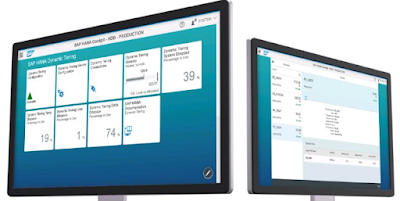What is SAP HANA and Why it's Important
What is SAP HANA and Why it's Important
One of the questions we get a lot from the people who are at the beginning of their SAP journey are: What is SAP HANA and why it's important?
You guys talk about it everywhere, but you never tell us what is ?
SAP HANA is a database in memory and HANA is actually an acronym: it means "high performance,
analytical device. "The idea is that it is an order of magnitude database faster than any traditional database that you can buy running on a disk.
What is SAP HANA?
Harness the power of your data and accelerate results-based innovation by developing smart, active solutions for real-time decisions and actions on a single copy of your data. It supports next generation transactional and analytical processing with a wide range of advanced analyzes, performed securely in hybrid and multicloud environments.
- Cloud, on-premise and hybrid deployments
- Safe and future-ready solution in memory
- Live intelligence with fast data processing
- Extensive advanced analysis with OLAP and OLTP processing combined on a single copy of data
Why is SAP HANA Important?
Because it is important? This is important because you have all these different pieces of
the business solution that now provides data back and forth, right? So you have a database that constantly absorbs data from all these different sources.
You have all the traditional business sources you are introducing and withdrawing data from, right?
So it will be your contracts and sales data, all normal things, things like that you did get in and out. But you also have UX and UI data: you have information that enters and exits your website, in and out of your forms.
And then you have the proliferation of mobile data. So that data comes from the cell phone devices, not only from your customers, but also from your workforce, right? As our workforce it becomes more and more mobile, you have more and more information coming from that Origin of the data.
And then you have all the pieces of machine learning, right? So what good is the data if you are won't you do interesting things with it? You have machine learning that reads both and then writing to that HANA database.
And then you have IoT sensors, right? Now we have IoT sensors in all, you it may have IoT devices in your factory, IoT devices in your warehouses, IoT devices that your presence points and points of sale.
IoT sensors are everywhere; and you understand a huge amount of data that all arrives and you need a database that can do it take care of it.
That's why HANA exists. HANA is the heart of your digital enterprise - it's the main database where everything feeds. And why it's important, right?
So, let's talk about S4 / HANA. So S4 / HANA is the application suite that works around it, you know, and therefore you have three fairly normal components that go into it.
The first will be your ERP: the traditional SAP product, the one that everyone knows of. But you also have the CRM part and you have an SRM part; these are all important components of this S4 / HANA distribution.
And then you have the really neat part, right? This is the piece that is located right here at the center is the NetWeaver stack. NetWeaver is an application platform that can be distributed applications on that conversation back and forth with this HANA database.
So, not only do you have incoming and outgoing data sources, but now you have everything the applications that accompany it.
So, you have applications that run on NetWeaver platform that comes directly from SAP, but anyone can also develop on NetWeaver platform, right? A third party, a business partner, a consultant: anyone can develop a specific application for your needs, which accompanies the NetWeaver platform.
And why does all this count? Well, what good is the data if you're not going to do something
with it, right? Otherwise, it is simply sitting out there - it is given in a warehouse, it is not
it matters.
This is where we start talking about the analytical pieces and I like to stop the analysis
group in three levels. So your first level will be your tactical level - they will be your business objects.
This is a WYSIWYG editor, in which any employee who has access to the system can go out and put together a query to get the data that they need to do their job. second piece is what I like to consider the corporate level, right? Is going to be your machine learning, your Leonardo, your Watson.
Here's where you're using lures the intelligence of going out and getting important information about your data that, otherwise, you may never know.
And then that third piece is what I like to think of as a strategic level - that's going on
to be your digital boardroom. So this is your C-suite and your board of directors they want
the top business view of what is happening in your system, of what is happening your factories.
But they want to look at it strategically, I want to see everything of my factories that once, all my warehouses simultaneously. And then I want to be able to drill after all: oh well, I see that we have a small uptime problem in this particular factory, or we have a kind of block in this warehouse or in this one piece of our inventory system or this piece.
More ABAP Tutorials:


Comments
Post a Comment